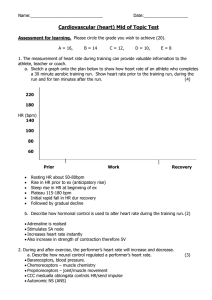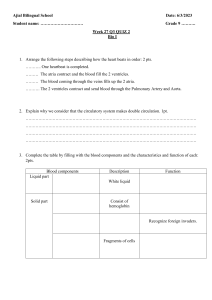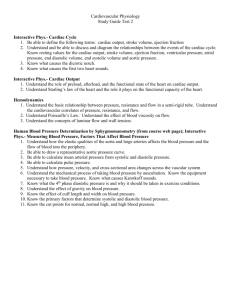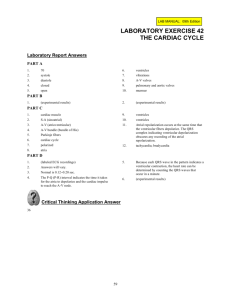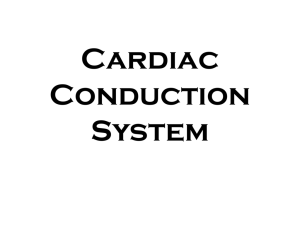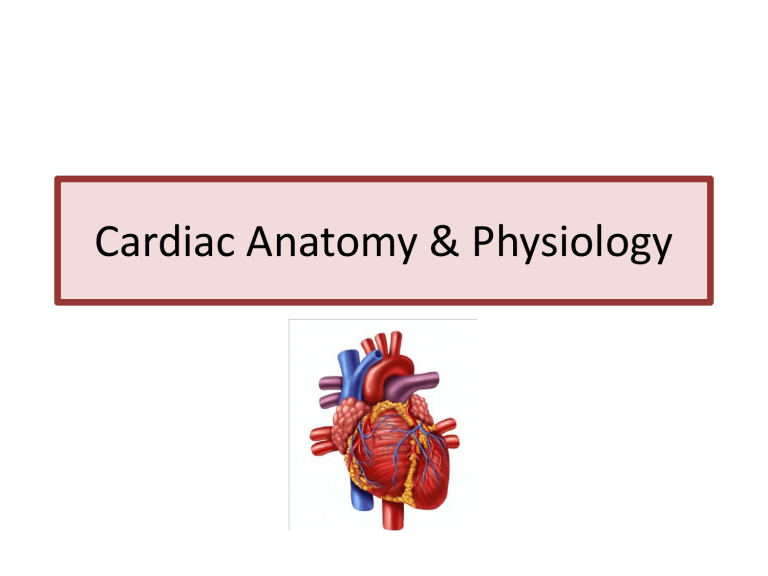
Cardiac Anatomy & Physiology Circulatory System The heart is a hollow muscular organ made of specialised cells that allow it to act as a pump within the circulatory system Cardiovascular and lymphatic systems make up the circulatory system a vast network of organs and vessels responsible for the flow of: • • • • Blood Nutrients Hormones Oxygen and other gases To and from the Cells of the body The Lymphatic system The Cardiovascular system • Lymph • Lymph nodes • Lymph vessels • Blood • Blood vessels • Heart The Heart The Heart is: • Located between the lungs in the centre and to the left of the midline • It is cone shaped and about the size of your own clenched fist • Can never stop pumping Primary Function is to drive blood through the cardiovascular system delivering : • Oxygenated blood to the tissues and organs of the body sufficient for their metabolic needs • Deoxygenated blood to the lungs for gaseous exchange Cardiovascular system The average human adult has 4-6 litres of blood repeatedly cycled throughout the body in a closed circulatory system. It is called a closed system because the blood is contained within the heart and blood vessels at all time and blood always flows in a forward direction. Arteries Heart Ventricles arterioles Capillaries / organs Veins Heart / atria Structures Human heart is divided into 4 chambers • 2 Atria and 2 Ventricles – these are hollow chambers which receive blood • They are surrounded by myocardial cells which are able to relax and contract The cardiovascular system consists of circuits: • Pulmonary circuit provides blood flow between the heart and lungs • Systemic circuit allows blood to flow to and from the rest of the body • Coronary circuit provides blood to the heart The heart valves ensure that blood flows in one direction through the system Coronary Circuit Conduction system There are 2 basic types of cardiac cell (Myocytes) • Myocardial cells contractile respond to an electrical impulse and contract • Specialised cells the conduction system generates electrical impulses and transmits them through the myocardium Site of electrical impulse generation Rate of impulse generation / min SA node 60 - 100 AV node 40 - 60 Ventricles < 40 The Cardiac Cycle Contraction of a chamber = Systole Relaxation of a chamber = Diastole End diastolic volume End systolic volume Introduction of Key Terms End Diastolic Volume = amount of blood in the ventricles at the end of filling / diastole End Systolic volume = amount of blood In the ventricles at the end of contraction / systole The ventricles never completely empty Stroke Volume = The amount of blood pumped out of the ventricles per beat / contraction (approx 70mls in a healthy adult male EDV – ESV = SV Introduction of Key Terms Cardiac Output (CO) Amount of blood ejected by the heart per minute = cardiac output (CO) In a healthy resting adult CO = approx 5-6 litres CO = Heart Rate x Stroke volume Ejection fraction is a measurement of the percentage of blood leaving your heart each time it contracts. Usually measured with imaging e.g. ECHO / cardiac catheterisation / MRI. Cardiac output and Ejection fraction are important indicators of how efficiently the heart can meet the demands of the body THANK YOU Key points The output form the right and left side of the heart must always balance. • THE AMOUNT OF BLOOD IN THE VENTRICLES AT THE END OF FILLING BEFORE SYSTOLE = END DIASTOLIC • THE AMOUNT OF BLOOD IN THE VENTRICLES AT THE END OF CONTRACTION OR SYSTOLE = END VOLUME End diastolic volume SYSTOLIC VOLUME - THE VENTRICLES NEVER COMPLETELEY EMPTY End systolic volume EDV – ESV = SV End diastolic volume = 125mls End systolic volume = 50mls The amount of blood pumped out of the ventricles per beat = stroke volume - approximately 70mls in a healthy adult male. In this example: 125ml – 50 mls = 75mls Key points Amount of blood ejected by the heart per minute = cardiac output (CO) in a healthy resting adult CO = approx 5-6 litres CO = Heart Rate x Stroke volume E.g. C0 = 70bpm x 75mls = 5,250mls Ejection fraction is a measurement of the percentage of blood leaving your heart each time it contracts. Usually measured with imaging e.g. ECHO / cardiac catheterisation / MRI. Cardiac output and Ejection fraction are important indicators of how efficiently the heart can meet the demands of the body
